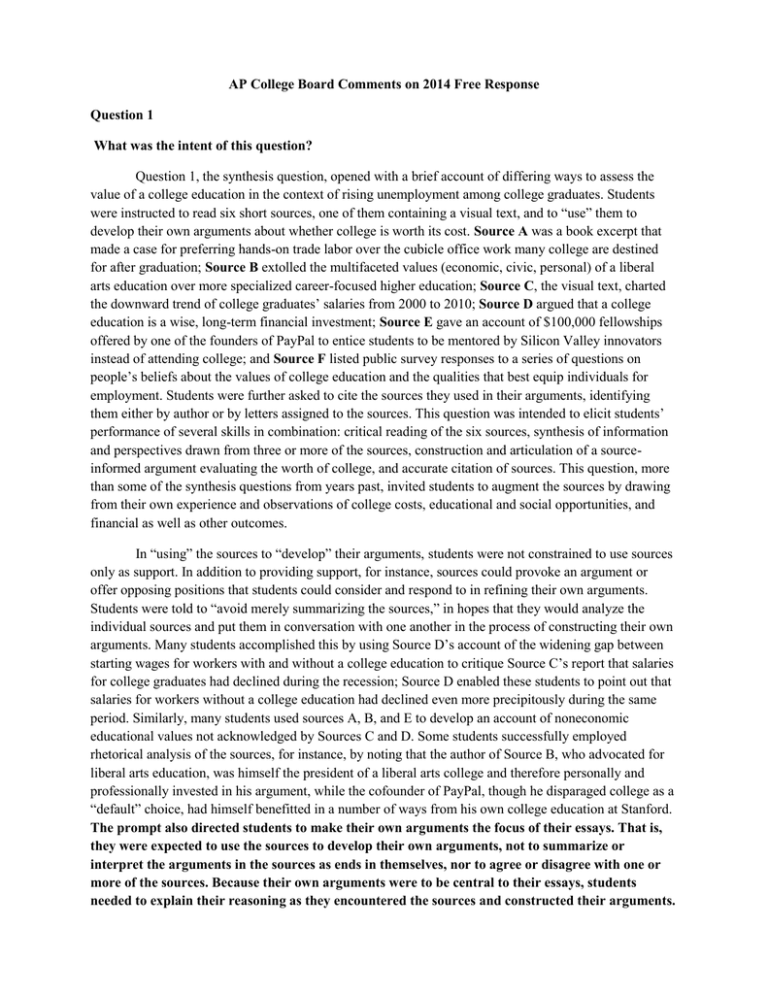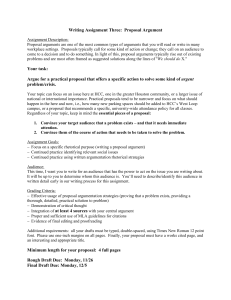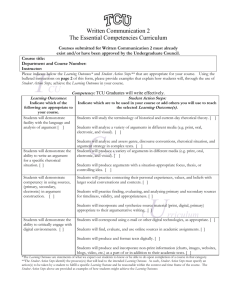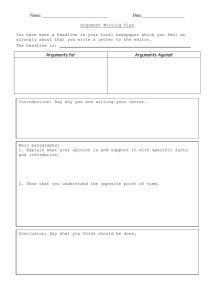AP College Board Comments on 2014 Free Response Question 1
advertisement

AP College Board Comments on 2014 Free Response Question 1 What was the intent of this question? Question 1, the synthesis question, opened with a brief account of differing ways to assess the value of a college education in the context of rising unemployment among college graduates. Students were instructed to read six short sources, one of them containing a visual text, and to “use” them to develop their own arguments about whether college is worth its cost. Source A was a book excerpt that made a case for preferring hands-on trade labor over the cubicle office work many college are destined for after graduation; Source B extolled the multifaceted values (economic, civic, personal) of a liberal arts education over more specialized career-focused higher education; Source C, the visual text, charted the downward trend of college graduates’ salaries from 2000 to 2010; Source D argued that a college education is a wise, long-term financial investment; Source E gave an account of $100,000 fellowships offered by one of the founders of PayPal to entice students to be mentored by Silicon Valley innovators instead of attending college; and Source F listed public survey responses to a series of questions on people’s beliefs about the values of college education and the qualities that best equip individuals for employment. Students were further asked to cite the sources they used in their arguments, identifying them either by author or by letters assigned to the sources. This question was intended to elicit students’ performance of several skills in combination: critical reading of the six sources, synthesis of information and perspectives drawn from three or more of the sources, construction and articulation of a sourceinformed argument evaluating the worth of college, and accurate citation of sources. This question, more than some of the synthesis questions from years past, invited students to augment the sources by drawing from their own experience and observations of college costs, educational and social opportunities, and financial as well as other outcomes. In “using” the sources to “develop” their arguments, students were not constrained to use sources only as support. In addition to providing support, for instance, sources could provoke an argument or offer opposing positions that students could consider and respond to in refining their own arguments. Students were told to “avoid merely summarizing the sources,” in hopes that they would analyze the individual sources and put them in conversation with one another in the process of constructing their own arguments. Many students accomplished this by using Source D’s account of the widening gap between starting wages for workers with and without a college education to critique Source C’s report that salaries for college graduates had declined during the recession; Source D enabled these students to point out that salaries for workers without a college education had declined even more precipitously during the same period. Similarly, many students used sources A, B, and E to develop an account of noneconomic educational values not acknowledged by Sources C and D. Some students successfully employed rhetorical analysis of the sources, for instance, by noting that the author of Source B, who advocated for liberal arts education, was himself the president of a liberal arts college and therefore personally and professionally invested in his argument, while the cofounder of PayPal, though he disparaged college as a “default” choice, had himself benefitted in a number of ways from his own college education at Stanford. The prompt also directed students to make their own arguments the focus of their essays. That is, they were expected to use the sources to develop their own arguments, not to summarize or interpret the arguments in the sources as ends in themselves, nor to agree or disagree with one or more of the sources. Because their own arguments were to be central to their essays, students needed to explain their reasoning as they encountered the sources and constructed their arguments. AP College Board Comments on 2014 Free Response Question 2 What was the intent of this question? Question 2 presented students with a short letter written by Abigail Adams in 1810 to her son, John Quincy Adams, who, at his parents’ urging, had accompanied his father on a diplomatic trip to France. Students were directed to read the letter carefully and then write an essay analyzing “the rhetorical strategies Adams uses to advise her son.” Finally, students were directed to support their analyses with specific references to the text. The intent of this question was to provide students with an opportunity to demonstrate their close reading skills (applied to a pre-20th-century text), to discern Abigail Adams’ rhetorical purposes, and to explain how she used written language upon a particular occasion in an effort to accomplish those purposes. The choice of the term “rhetorical strategies” rather than “rhetorical devices” was intended to emphasize the priority of function over form in rhetorical analysis. The prompt was meant to guide students away from “figure hunting” (i.e., identifying metaphors, assonance, synecdoche, etc.) and toward an account of how Adams intended her letter to function as a means of convincing her son to assume the perspective and embark upon the course of action she was urging him to take. Part of the rhetorical analysis task is constructing the rhetorical context in which language performs its function. In this case, students were helped to construct the context by the date of the letter and by a brief account in the prompt of the writer and recipient of the letter and the historical moment in which the letter was written. Students could also draw upon their own historical knowledge or their understanding of family relationships or class values to supplement this sketch of the context. In requiring students to refer specifically to the text, the prompt invited students to demonstrate their abilities to select and use appropriate textual evidence to illustrate and support the assertions they made about Adams’ rhetorical strategies. AP College Board Comments on 2014 Free Response Question 3 What was the intent of this question? Question 3, the argument question, begins by recounting a research claim that the “creativity quotient” of American young people, particularly those in kindergarten through sixth grade, has declined. Students were asked to consider this claim in the context of looming, unprecedented global crises that require creative responses (e.g., pollution in the Gulf of Mexico and the war in Afghanistan). Finally, students were asked to consider whether one particular attempt to solve the creativity crisis — adding a separate class in creativity — was a viable solution for their own schools to implement. In an effort to help students focus and address their arguments to an audience with the capacity to take action, the prompt asked students to address their arguments to their school boards. Because specifying an audience was intended to help students respond successfully to the prompt, not to give them a way to fail, students were not penalized for not writing in the form of a letter or for not explicitly addressing their arguments to their school boards. While some students had a clear understanding of who makes up their school boards and how the school board functions, others did not. So while some students may have been rewarded in the scoring for skillfully employing a rhetorical strategy such as appealing to shared values such as quality education, community involvement, and finding solutions to global problems, students were not penalized for using other argument strategies. The question was intended to give students an opportunity to demonstrate their abilities to produce sound and convincing arguments in support of clearly articulated positions. Unlike some argument questions from previous years, this year’s prompt gave students an either/or choice — to argue for or against establishing a creativity class in their school’s curriculum. Unlike some previous years’ argument prompts that required students to build arguments about abstract concepts (e.g., last year’s argument prompt about the relationships between ownership and sense of self), this year’s prompt explicitly directed students to supply their own definitions of “creativity.” This explicit direction was intended to underscore the importance in argumentation of defining terms that might otherwise be differently interpreted by audience members.





